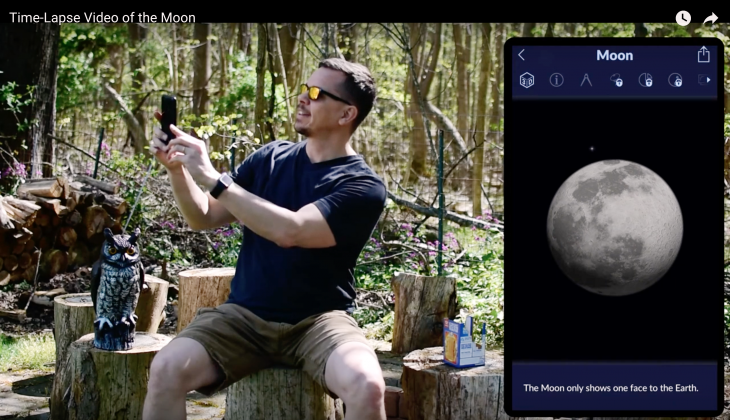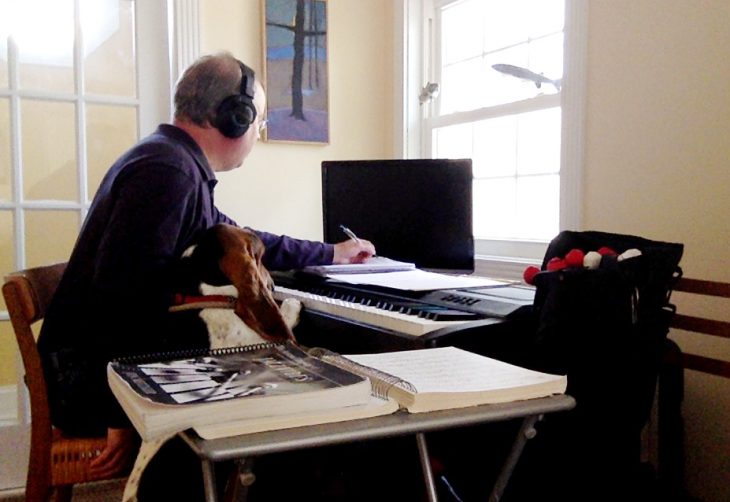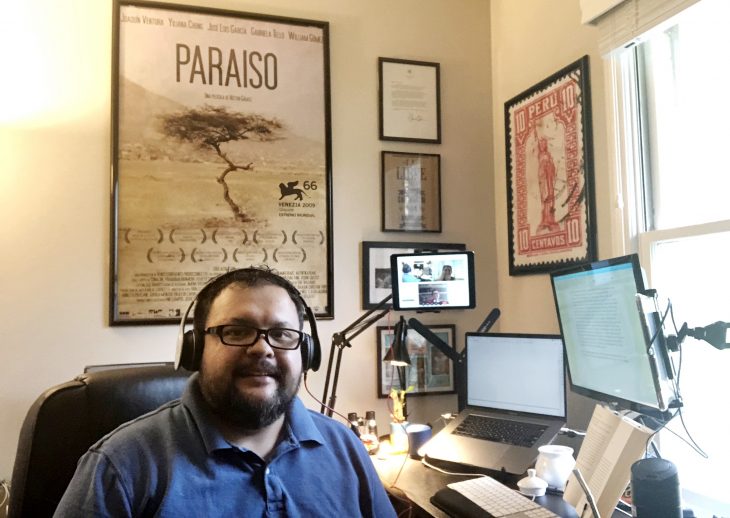Elon faculty share how they have transformed their homes into creative and meaningful work spaces.
While Elon’s campus is closed to stop the spread of COVID-19, the faculty have set up shop at home. They have converted sections of their backyards into labs, co-opted their partner’s desks and cleared space in sun-lit corners as they continue to engage with their students remotely. Here some Elon faculty members share photos of themselves working at home and some thoughts about their experiences.
Patti Burns, lecturer in French, and her husband, Dan Burns, assistant professor of English
We’re making the best of working remotely during this pandemic. On nice days, we enjoy getting out into the yard to work in the sunshine while our kids run off some energy (go, future Elon soccer!). It’s great to be able to bounce ideas and questions off each other as we rapidly rework our courses for online instruction. We’re relatively new transplants to the town of Elon, and it’s comforting to still hear the train running through town as we work.
Our routines are completely new, and we talk with our students about the challenges that they, too, are facing and how we can work together successfully in this virtual environment. We read frequently with our children and loved the article about how Elon rallied together during the Spanish Flu. It reminded us, once again, that Elon has long been a community that works creatively to overcome seemingly insurmountable obstacles.
Pablo Celis-Castillo, assistant professor of Spanish
I always wanted to have an office like the one my father has at his house in Cajamarca, Peru. His office has a large desk full of old newspapers, dictionaries and encyclopedias. I have tried to recreate a similar welcoming environment. I also have a large, messy desk and bookshelves full of well-read books. I have a large collection of vinyl records, and, as is usually the case in my father’s office, there’s always music playing in the room. Most recently I was listening to Bach and Thelonious Monk.
The artwork includes some pieces that are quite meaningful for me. For instance, there’s a large poster of “Paraíso,” a great Peruvian film from 2009, and a framed paper bag from “La Libre,” an amazing independent bookstore in Lima that is now closed. In the last couple of weeks there have been a few additions to my office: a new bookshelf, a playpen, a million toys and two really energetic little girls.
Kirstin Ringelberg, professor of art history

Our house is an 1835 farmhouse in Mebane, and I like the way this room shows its history, in stages, and how it’s used—for thinking, designing, imagining and working. It’s the home office of my partner, Anna, who’s an architect, and in the photo I’m teaching Art History Methods. On the wall behind the desktop is a drawing by Anna. It includes a building and a crater, or rather a conceptualization of the start of a crater combined with the action of how the crater was made. The crack in the plaster draws a path to what created the impact. It was a thought piece on time as nonlinear, simultaneous, and how things make change.
I think that given the way this shift in our lives has happened it’s helpful to be able to see my students, and to have them see each other and me, on a regular basis. They can see that we’re all somewhere, getting through it in our own ways and that we have each other. We always have someone to talk to about how we’re doing—be it in learning how critical race theory works in art history or in managing our own versions of house, home, face, screen, mind and self.
Tony Crider, professor of astrophysics

I’m actually filming most of my astronomy lab videos in my backyard, and I have been using a plastic owl to serve as a stand-in for me when setting up cameras. I made a lesson to teach astronomy lab students how to make a smartphone holder out of a Pop-Tarts box since they can’t use the tripods we have on campus. The video tutorials keep going slightly awry, though, but the mistakes make the videos more amusing, so I’ve left them all in.
For several years in my “Technology and Society” class, we’ve talked about how rooms in houses will be repurposed for other things in the future (e.g., no longer needing garages when we have robotic Uber). Thus, it’s been interesting to see millions of people now quickly turning corners of their houses into home studios.
Elena Kennedy, assistant professor of entrepreneurship

My office is in our sunroom, and I’ve got great natural light most of the day plus a pretty view of our street and Elon University Forest beyond that. I really enjoy being able to see what’s going on, especially as more people in our neighborhood are home and spending time outside.
I discovered several years ago that I am more comfortable sitting on an exercise ball than at a desk chair, and I have a silver ball in my office and an orange ball at home. It helps my lower back and takes more active work than sitting in a chair, which keeps me more focused. One challenge is that our dogs consider my office to be their room, and they often make appearances in the background as I chat with students and other Elon folks on WebEx.
Jon Metzger, professor of music

Fortunately for me, my wife designs houses, so our space is beautiful! I am especially enjoying looking out a window while I teach. I’m using the keyboard for most of my teaching—playing through students’ written work and writing out future assignments. Our one-year-old basset hound, Ellie, doesn’t understand at times why I am at home and not giving her all of my attention. Here she’s offering insight on a 12-bar blues in G.
My mallet bag is ready for the times I roll my vibraphone in for use. And the fish hanging in the window remind me that fishing season is thankfully upon us again!



